
SoulCycle is much in the news this past week as it struggles to address a growing viral consumer boycott of itself, along with Related Companies-related brand Equinox, by customers angry about the decision by brand owner Stephen Ross to host a $100,000-per-plate fundraising event for Donald Trump in the Hamptons.
Consumer boycotts such as this — whether you agree with them or not — are enabled by increased awareness on the part of consumers. This awareness can be driven by any one of a number of channels, e.g. following an article link on a website, a Twitter feed, text/email, or other online source. Or — as is very often the case — it may be driven into hyperdrive by going to a search engine and simply typing in the name of the brand. Search engines — whose engineers are dedicated to the proposition that users need experience a “holistic” (all data in one place) view of the queried entity — are especially good places to surface any controversies surrounding a given brand at a given time. Let’s assess the brand damage happening right now on Google.
We’ll also take a look at Bing because the results are very different there. The algorithms used by Google and Bing are very different and — according to SEO experts such as Bruce Clay – have been diverging from each other for at least the past decade.
On Friday, August 9, I went to Google (logged out) and typed in “Soul Cycle.” My purpose in so doing was to simulate the experience of a consumer who was ignorant of the controversy. (I repeated my experiment using the term “SoulCycle” (without a space between ‘Soul’ and “Cycle’ and received identical results for those reported for “Soul Cycle” (with the space). Each screenshot is annotated to indicate how different areas of Google (“News,” “Videos,” etc.) reacted to the emergence of the controversy
Exhibit 1: Google Autocomplete
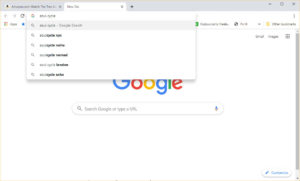 Note that at the time I did my search (Noon EST on Friday, August 9th), Autocomplete shows nothing related to the boycott – a verification that Autocomplete lags well behind Google’s other areas in terms of being up to date.
Note that at the time I did my search (Noon EST on Friday, August 9th), Autocomplete shows nothing related to the boycott – a verification that Autocomplete lags well behind Google’s other areas in terms of being up to date.
Exhibit 2: Google “All” Tab
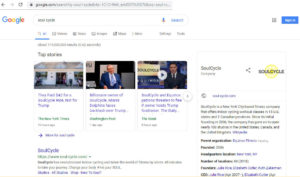
It’s practically impossible for brands to insulate consumers from learning about controversies on Google. Even if users are not looking for news, and restrict their visits to the “All” tab, Google will insert a “News Panel” should there be enough news to populate this area. Yes – the official SoulCycle organic result is still listed – but it’s been forced down near the fold – that’s a long way from the place where most people click (the upper left-hand corner).
Exhibit 3: Google “Images” Tab
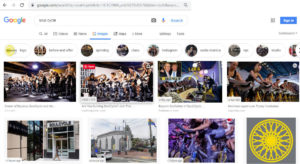 Brands involved in a fast-rising controversy get little shelter on Google Images, where the entire top row of images concern the controversy. The second row – at least at this point in time – remains undisturbed. Google appears to update its Images Tab very frequently these days.
Brands involved in a fast-rising controversy get little shelter on Google Images, where the entire top row of images concern the controversy. The second row – at least at this point in time – remains undisturbed. Google appears to update its Images Tab very frequently these days.
Exhibit 4: Google “Videos” Tab
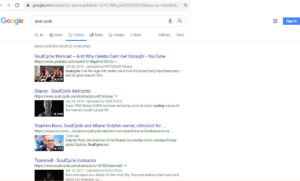
Google’s “Video” Tab appears to provide more temporary shelter for brands engaged in a controversy. Only the 3rd video concerned the controversy; the others are free of it. I would expect that as more video content concerning the boycott flows from major publishers, brand damage in this area will become more difficult to contain.
Exhibit 5: Google “News” Tab

No big surprise here – all the news (at least on this Friday) concerned the boycott.
What About Bing?
On Bing, it’s a different situation right now. This search engine seems to be a bit “sleepier” than Google in terms of integrating fast-breaking information into its other high-traffic areas. (Whether that’s good or bad is beyond the scope of this article). Let’s take a look at how Bing is handling the SoulCycle/Equinox boycott controversy.
Exhibit A: Bing “All” Tab
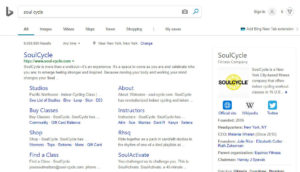 News isn’t incorporated into Bing’s “All” Tab as quickly as it on Google. This screenshot – taken 10 minutes after the Google screenshots — shows nothing related to the controversy. This creates a very different set of results that are more brand-friendly than on Google.
News isn’t incorporated into Bing’s “All” Tab as quickly as it on Google. This screenshot – taken 10 minutes after the Google screenshots — shows nothing related to the controversy. This creates a very different set of results that are more brand-friendly than on Google.
Exhibit B: Bing “Images” Tab
 Ditto on Bing’s “Images” Tab. While the labels associated with each image indicate a recent upload time, none relate to the controversy. This markedly departs from Google’s presentation on its “Images” Tab.
Ditto on Bing’s “Images” Tab. While the labels associated with each image indicate a recent upload time, none relate to the controversy. This markedly departs from Google’s presentation on its “Images” Tab.
Exhibit C: Bing “Video” Tab
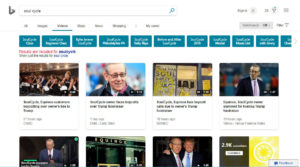
Unlike Bing’s “Images” Tab, the “Video” Tab appears to be very frequently updated. 7 of the 8 images in the first two rows concern the controversy. This, in my view, reflects Bing’s well-documented strengths in surfacing relevant video content.
Exhibit D: Bing “News” Tab
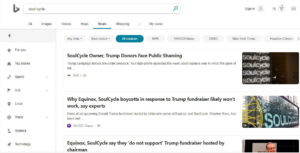 Bing’s News Tab reflects the current controversy very similarly to Google’s algorithmic treatment, drawing recent articles from mainstream online news sources. This bucket will be in a non-empty state for the next month (at least).
Bing’s News Tab reflects the current controversy very similarly to Google’s algorithmic treatment, drawing recent articles from mainstream online news sources. This bucket will be in a non-empty state for the next month (at least).
The Takeaway for Brands
The bottom line – on Google – is that users – even if they began their query with no intention of having to take sides re SoulCycle, will likely be apprised of the controversy right after entering their query. Some may brush it off; others may dive into a news story, still others may be stimulated by what they consume toward other action (pro or con) regarding the boycott. While nothing that Google is doing reflects any position on the dispute, the way it works leads users inescapably into the jaws of controversy surrounding any brand, and there’s nothing anyone can do about it (perhaps if Google allowed advertisers to pay to message users in more of its areas – especially in its “News” tab, that would change, but there’s no indication Google ever intends to do this).
Search engines – especially Google – are getting so good at integrating fast-moving (news) information into their non-news areas that it’s impossible for users to avoid learning about controversies concerning the brands they patronize. There’s nothing nefarious about this – it’s just a reflection of the way these engines work to integrate information from disparate sources on a near real-time basis.
Brands can do very little to push back on the brand damage that occurs on search engines. Eventually – perhaps in a few weeks, the balance of news to non-news information will shift in their favor, but – at least for the short term – all they can do is “batten down the hatches” and wait for the sea to calm.
Of course, they could go ahead and make some news themselves, and attempt to influence the coverage that way. But that’s an uphill battle that will likely entail taking the bull of controversy by the horns and reckoning with it in a way that satisfies part of its consumer base – perhaps at the risk of alienating another part of it. Brands must make such difficult choices on a regular basis today, which – like it or not – is the price of visibility in the age of Google (and to a lesser extent, the age of Bing).

